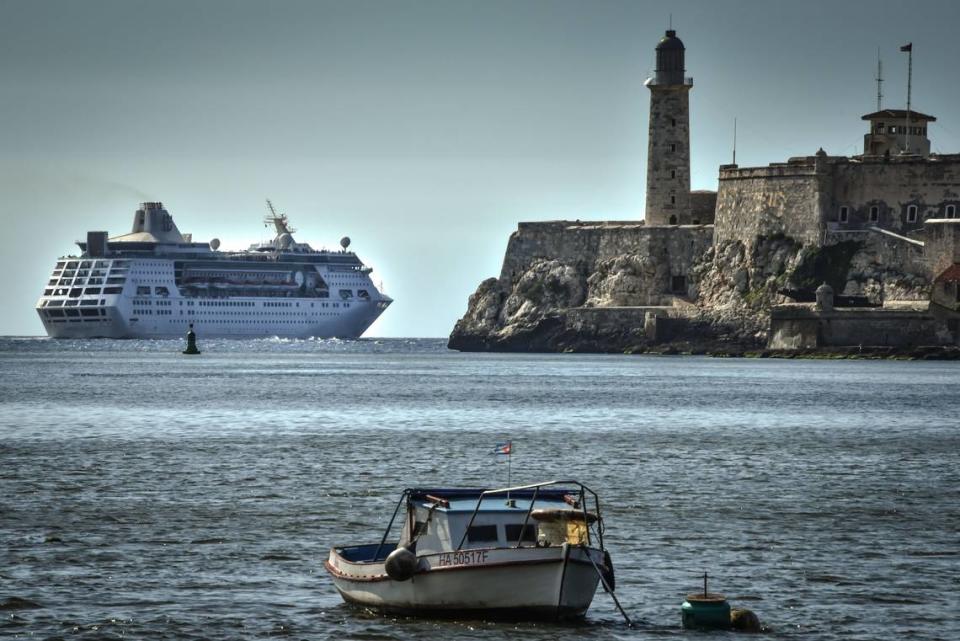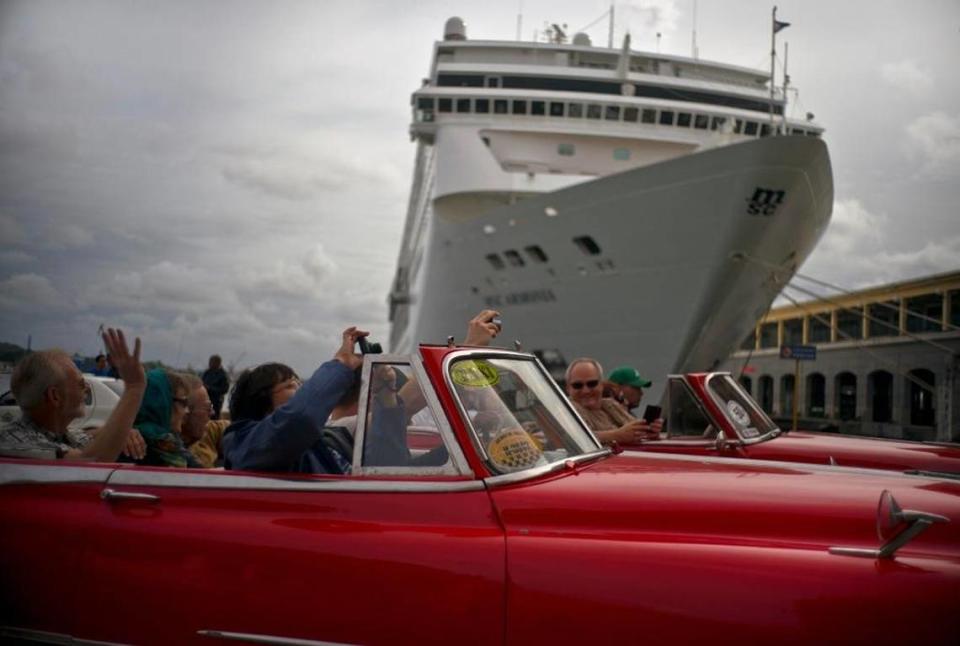U.S. cruise ships brought a boom to Cuba. Now, some small businesses are struggling.
Earlier this year, two cruise ships at a time were often docked at the terminal along Havana’s seaside Malecón. A fleet of candy-colored classic cars and tour guides waited nearby to squire passengers around the city.
That ended abruptly with the Trump administration’s June 4 announcement that it was cutting off all cruise travel from the United States to Cuba, as well as ending the popular people-to-people category of travel that allowed cruise passengers to legally visit Cuba despite the embargo.
Until then, cruises had been the fastest growing sector of Cuba’s international visitor market and had provided a welcome addition to not only government coffers but also the pockets of private entrepreneurs.
After five months without a cruise ship on the horizon, the MS Hamburg, operated by Germany’s Plantours Kreuzfahrten, arrived in Havana on Oct. 30, from Montego Bay, Jamaica. The ship, which carries around 400 passengers, also called in Cayo Largo, María la Gorda, Cienfuegos, Trinidad and Santiago.
A Greek cruise ship visited Havana in November.
Plantours is offering two more 11-day cruises to Cuba in 2020. The Marella Discovery 2, operated by the British company Marella Cruises, also is scheduled to call in Havana in January as part of a Caribbean cruise that begins in Montego Bay. Marella’s larger ship, Marella Discovery 2 carrying nearly 2,000 passengers, has only scheduled three itineraries with stops in Havana in 2020.
Cuba can now say it’s back in the cruise business, but the European-based cruise companies can’t begin to make up for the loss of the booming U.S. cruise market.
Cruises were a simple and legal way for Americans to experience Cuba before the rule change. While Cuba received 4.7 million international visitors in 2018 and had hoped for 5 million this year, tourism ministry officials have now revised their 2019 estimates down to 4.3 million international visitors.
By Dec. 11, Cuban Tourism Minister Manuel Marrero Cruz said that 4 million international visitors had arrived in Cuba and more were on the way, putting Cuba within striking distance of its lowered target.
During the first half of the year, José Luis Perelló, a Cuban economist, estimates that 372,857 air and sea arrivals were American visitors. During the second half of the year, he expects that number will fall to about 100,000 American visitors. (Cuban-American visitors are counted separately.)
Although the U.S. cruise industry lobbied intensely to preserve the Cuba sailings, the new rules went into effect June 5.
“No one expected him [President Donald Trump] to suspend cruise ships because the loss is to the cruise companies,” said Perelló. The new measures meant 30,000 fewer cruise passengers in June alone and dashed Cuba’s hopes of a new record for cruise visitors this year.

Since May 2016, when Carnival Corp.’s Fathom Adonia became the first U.S.-based cruise ship to call on Cuba in more than 50 years, at least nine cruise lines added itineraries that included one or more stops in Cuba. The policy shift left them scrambling to add new Caribbean ports of call to make up for the loss of the Cuba visits.
Cruise Lines International Association said that nearly 800,000 passenger bookings that were scheduled or already underway were affected by the abrupt rule change.
It also meant a hit to the cruise companies’ bottom lines.
In its second quarter earnings report, Carnival Corp. said the policy change had a financial impact of 4 to 6 cents per share. “While the company was able to quickly adjust its itineraries to provide guests with attractive alternative vacation experiences, the suddenness of the regulatory changes to this high-yielding destination has led to a near-term impact on revenue yields,” said Carnival in a statement.
About 100 Carnival Cruise Line itineraries departing from seven ports had to be revised because of the rule change; destinations in the Bahamas, Dominican Republic, Jamaica, Mexico, Bermuda, Grand Cayman, Honduras and Jamaica were quickly subbed in. About 120,000 Carnival line guests were impacted, the cruise company said.
Carnival’s Seabourn Cruise Line planned five itineraries to launch in November that included stops in Cuba on the 458-passenger Sojourn. Those sailings were reworked and passengers were given the option of rebooking on other Caribbean routes.
On Carnival’s Holland America Line, which was scheduled to begin its sailings this fall, 10,500 passengers on 57 cruises scheduled through spring 2021 were affected. Some passengers have canceled; others are being rebooked on other Caribbean sailings.
Royal Caribbean’s Empress of the Seas, which sailed into Havana as the new rules were being announced, was the last cruise ship based in the United States to call on Cuba and it left the port the next day. In its second quarter report, it too noted increased costs related to the travel restrictions that required it to change its lucrative Cuba sailings “on short notice, which impacted our earnings.”
Other cruise lines also reported an adverse impact from the change in Cuba regulations.
ROLLBACK
Allowing Americans to take cruises on ships departing from U.S. ports was one of the steps taken during the Obama administration’s rapprochement with Cuba. Since taking office, Trump has steadily rolled back those normalization efforts.
“Cuba remains communist, and the United States, under the previous administration, made too many concessions to one of our historically most aggressive adversaries,” said Commerce Secretary Wilbur Ross when the new sanctions were announced. “The Trump administration recognizes the threat Cuba’s government poses in the region, and the Commerce Department is acting to limit commercial activity that provides revenue for the Cuban regime.”
The cruise ships were also a target because administration officials said they represented disguised tourism. While American travelers may visit Cuba for specific reasons such as family visits, professional research, support for the Cuban people and humanitarian missions, they aren’t authorized to travel to Cuba for tourism activities.
Tying the cruises up with its efforts to dislodge the leftist regime of Nicolás Maduro in Venezuela, the State Department said that “veiled tourism has served to line the pockets of the Cuban military, the very same people supporting Nicolás Maduro in Venezuela and repressing the Cuban people on the island.”

But not everyone buys the notion that the Cuban military was benefiting greatly from cruise travel.
“The amount of money flowing in from cruise ships wasn’t that much,” said Richard Feinberg, a University of California San Diego professor who has published extensively on the Cuban economy.
Cruise passengers, he noted, tended to spend less in Cuba than passengers who arrive on commercial flights. That’s because air travelers usually spend more time on the island, book lodging and tend to eat at restaurants more.
But the Cuban government will be deprived of docking fees, as well as revenue for shore excursions, tour buses and bookings at state-run restaurants.
“It’s difficult to make sense of this policy because it so clearly undercuts our security interests in Cuba,” said Feinberg, who was a national security adviser during the Clinton administration. “First, it undermines the private sector, especially in Havana, and it empowers the hardliners in Cuba who say you can’t trust the Americans.”
Florida Republican Sen. Marco Rubio, a proponent of the sanctions, said it’s “false” that Trump’s policy has hurt civilian owners of restaurants and property rentals.
“If you want to go to Cuba you still can,” he said on Twitter. “But instead of giving your money to companies owned, controlled and operated by the regime you have to go on a trip where your $ goes directly to individual private Cubans.”
But the Trump administration had already taken aim at entities controlled and operated by the Cuban military, which is heavily involved in the Cuban tourism industry, by placing such hotels, restaurants, shops, tour companies and other businesses on a blacklist. Americans are prohibited from dealing with them, and U.S.-based tour companies and cruise lines were already avoiding them. The U.S. published its first restricted list in November 2017 and now there are more than 230 Cuban businesses on it.
FEELING THE PAIN
Further complicating travel to the island is a new U.S. sanction that cuts off air travel from the United States to all Cuban cities except Havana. It went into effect Dec. 10.
Many private Cuban entrepreneurs and artists say limiting American travelers is hurting them.
During the doldrums after the U.S. cruises were cut off, the only action near Havana’s cruise terminal was provided by fishermen lazily casting lines.
At nearby Plaza Vieja, which once teemed with cruise passengers, José Carlos Melo González contemplated the empty tables at the privately owned Café Bohemia. Americans, said the cafe manager, once accounted for nearly 100 percent of clientele. That went down to 10 percent after the new cruise rules went into effect. He’s now trying to come up with creative strategies to draw in other customers.
“Almost 99 percent of the restaurants in the Havana harbor area are private restaurants; the crafts sold there are 100 percent Cuban-made,” said Giulio Ricci, a Cuban economist. “The real impact has been on the entrepreneurs. They’re either sad or mad.”
At the Taller Experimental de Gráfica in Old Havana, a group of graphic artists sat talking among themselves during the cruise drought. There were no customers.
“When the cruise ships were coming, there was an avalanche of people. Now we’re back the way we were,” said Julio Cesar Peña Peralta, who sold one of his prints to Michelle Obama when President Obama visited in March 2016.
“Whatever measures were taken to affect the government you’ve got to remember they’re also affecting Cuban families,” he said. “Government people also have their families and children.”
Melo, the manager of Café Bohemia, said the private restaurant/bakery, which sits in the courtyard of an 18th century building that also rents private rooms to visitors, let four employees go after the sanctions went into effect.
“We’re just two blocks from the port. At times there were 1,000 people walking around the streets of Old Havana,” said Melo. “The day after [the rule change], it was nothing.”
When there are fewer customers, it’s not only the cafe employees who suffer but a whole network of private workers, Melo said. “I buy the food for the restaurant from private farmers. A woman provides the filtered water; this one does the laundry; another cleans the rooms. Another family gets the vegetables for the restaurant.”
To woo customers, now mostly Europeans and Mexicans, Melo has put more tables outside the heavy wooden doors guarding the courtyard, hired a band and improved the lighting so the restaurant is more visible. Daily specials are entered on a chalk board easily visible from the street.
“I’m trying to figure out the market. I need to do something,” he said.

